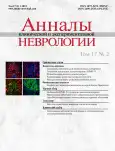Single-Stage Extracranial and Intracranial Stenting of the Internal Carotid Artery in a Patient with Open Circle of Willis and Associated Renovascular Hypertension
- Authors: Agarkov M.V.1,2, Safuanov A.A.1, Evreeva S.T.1, Gertsog O.B.1, Safuanova O.S.1, Popov V.V.3, Khilchuk A.A.3
-
Affiliations:
- Gusev Central District Hospital
- Saint-Petersburg Institute of Bioregulation and Gerontology
- City Hospital No. 40
- Issue: Vol 17, No 2 (2023)
- Pages: 84-91
- Section: Clinical analysis
- URL: https://journals.rcsi.science/2075-5473/article/view/131733
- DOI: https://doi.org/10.54101/ACEN.2023.2.11
- ID: 131733
Cite item
Full Text
Abstract
We describe a case of 72-year-old patient with recurrent transient ischemic attacks in the right internal carotid artery (ICA) territory associated with uncontrolled hypertension. Duplex ultrasonography und carotid angiography showed a < 60% stenosis with signs of a vulnerable plaque in the cervical segment, as well as a < 90% stenosis in the cavernous segment of the right ICA. After further examination the patient was diagnosed with an 80% renal artery stenosis. First, the patient had a single-stage stenting for extracranial and intracranial stenoses of the right ICA, then left renal artery stenting. No intraoperative and postoperative complications were observed. These results show that this surgical treatment is minimally invasive, safe, and effective in symptomatic patients and may be considered for the disease.
Full Text
##article.viewOnOriginalSite##About the authors
Maksim V. Agarkov
Gusev Central District Hospital; Saint-Petersburg Institute of Bioregulation and Gerontology
Author for correspondence.
Email: Dr.agarkovmv@gmail.com
ORCID iD: 0000-0002-6304-2553
SPIN-code: 8861-6321
Chief, Department of interventional radiology
Russian Federation, Gusev; Saint-PetersburgAlexey A. Safuanov
Gusev Central District Hospital
Email: annaly-nevrologii@neurology.ru
ORCID iD: 0000-0002-7878-2490
interventional radiologist, Department of interventional radiology
Russian Federation, GusevSvetlana T. Evreeva
Gusev Central District Hospital
Email: evreeva.sveta@yandex.ru
ORCID iD: 0000-0002-8915-3673
interventional radiologist, Department of interventional radiology
Russian Federation, GusevOlga B. Gertsog
Gusev Central District Hospital
Email: annaly-nevrologii@neurology.ru
Сhief doctor
Russian Federation, GusevOlga S. Safuanova
Gusev Central District Hospital
Email: annaly-nevrologii@neurology.ru
ORCID iD: 0000-0002-1333-0071
vascular surgeon
Russian Federation, GusevVitaly V. Popov
City Hospital No. 40
Email: annaly-nevrologii@neurology.ru
ORCID iD: 0000-0003-2073-8080
Cand. Sci. (Med.), interventional radiologist, Department of interventional radiology
Russian Federation, SestroretskAnton A. Khilchuk
City Hospital No. 40
Email: annaly-nevrologii@neurology.ru
ORCID iD: 0000-0002-7199-0502
Cand. Sci. (Med.), interventional radiologist, Department of interventional radiology
Russian Federation, SestroretskReferences
- Munster A.B., Thapar A., Davies A.H. History of carotid stroke. Stroke. 2016;47(4):e66–e69. doi: 10.1161/STROKEAHA.115.012044
- Friedman S.G., Rich N.M. The first carotid endarterectomy. J. Vasc. Surg. 2014;60(6):1703.e1-4–1708.e1-4. doi: 10.1016/j.jvs.2014.08.059
- DeBakey M.E. Successful carotid endarterectomy for cerebrovascular insufficiency: nineteen-year follow-up. J. Am. Med. Assoc. 1975;233(10):1083–1085.
- Kerber C.W., Cromwell L.D., Loehden O.L. Catheter dilatation of proximal carotid stenosis during distal bifurcation endarterectomy. Am. J. Neuroradiol. 1980;1(4):348–349.
- Mathias K. Perkutane transluminale Katheterbehandlung supraaortaler Arterienobstruktionen. Angio. 1981;3:47–50.
- Suri M.F.K., Johnston S.C. Epidemiology of intracranial stenosis. J. Neuroimaging. 2009;19(suppl. 1):11S–16S. doi: 10.1111/j.1552-6569.2009.00415.x
- Connors J.J., Wojak J.C. Percutaneous transluminal angioplasty for intracranial atherosclerotic lesions: evolution of technique and short-term results. J. Neurosurg. 1999; 91(3):415–423. doi: 10.3171/jns.1999.91.3.0415
- Marks M.P., Marcellus M., Norbash A.M. et al. Outcome of angioplasty for atherosclerotic intracranial stenosis. Stroke. 1999;30(5):1065–1069. doi: 10.1161/01.str.30.5.1065
- Marks M.P., Marcellus M.L., Do H.M. et al. Intracranial angioplasty without stenting for symptomatic atherosclerotic stenosis: long-term follow-up. Am. J. Neuroradiol. 2005;26(3):525–530.
- SSYLVIA Study Investigators. Stenting of Symptomatic Atherosclerotic Lesions in the Vertebral or Intracranial Arteries (SSYLVIA): study results. Stroke. 2004;35(6):1388–1392. doi: 10.1161/01.STR.0000128708.86762.d6
- Chimowitz M.I., Lynn M.J., Derdeyn C.P. et al. Stenting versus aggressive medical therapy for intracranial arterial stenosis. N. Engl. J. Med. 2011;365(11):993–1003. doi: 10.1056/NEJMoa1105335
- Alexander M.J., Zauner A., Chaloupka J.C. et al. WEAVE Trial: final results in 152 on-label patients. Stroke. 2019;50(4):889–894. doi: 10.1161/STROKEAHA.118.023996
- Wang Z.L., Gao B.L., Li T.X. et al. Severe symptomatic intracranial internal carotid artery stenosis treated with intracranial stenting: a single center study with 58 patients. Diagn. Interv. Radiol. 2016;22(2):178–183. doi: 10.5152/dir.2015.15191
- Zaidat O.O., Fitzsimmons B.F., Woodward B.K. et al. Effect of a balloon-expandable intracranial stent vs medical therapy on risk of stroke in patients with symptomatic intracranial stenosis: the VISSIT randomized clinical trial. JAMA. 2015;313(12):1240–1248. doi: 10.1001/jama.2015.1693
- Flusty B., de Havenon A., Prabhakaran S. et al. Intracranial atherosclerosis treatment: past, present, and future. Stroke. 2020;51(3):e49–e53. doi: 10.1161/STROKEAHA.119.028528
- Lyden P. Using the National Institutes of Health Stroke Scale: a cautionary tale. Stroke. 2017;48(2):513–519. doi: 10.1161/STROKEAHA.116.015434
- Mokin M., Primiani C.T., Siddiqui A.H., Turk A.S. ASPECTS (Alberta Stroke Program Early CT Score) measurement using Hounsfield Unit values when selecting patients for stroke thrombectomy. Stroke. 2017;48(6):1574–1579. doi: 10.1161/STROKEAHA.117.016745
- Fedak A., Ciuk K., Urbanik A. Ultrasonography of vulnerable atherosclerotic plaque in the carotid arteries: B-mode imaging. J. Ultrason. 2020;20(81): e135–e145.
- Brinjikji W., Huston J. 3rd, Rabinstein A.A. et al. Contemporary carotid imaging: from degree of stenosis to plaque vulnerability. J. Neurosurg. 2016;124(1):27–42. doi: 10.3171/2015.1.JNS142452
- Achit H., Soudant M., Hosseini K. et al. Cost-effectiveness of thrombectomy in patients with acute ischemic stroke: The THRACE Randomized Controlled Trial. Stroke. 2017;48(10):2843–2847. doi: 10.1161/STROKEAHA.117.017856
- Hacking C., Gaillard F. Bouthillier classification of internal carotid artery segments. Radiopaedia.org. 2008. URL: https://radiopaedia.org/articles/4714. doi: 10.53347/rID-4714
- Hindenes L.B., Håberg A.K., Johnsen L.H. et al. Variations in the Circle of Willis in a large population sample using 3D TOF angiography: The Tromsø study. PLoS One. 2020;15(11):e0241373. doi: 10.1371/journal.pone.0241373
- Hacking C., Babu V., Morgan M. et al. Thrombolysis in cerebral infarction (TICI) scale. Radiopaedia.org. 2015. URL: https://radiopaedia.org/articles/39569. doi: 10.53347/rID-39569
- Li J.C., Jiang Y.X., Zhang S.Y. et al. Evaluation of renal artery stenosis with hemodynamic parameters of Doppler sonography. J. Vasc. Surg. 2008;48(2):323–328. doi: 10.1016/j.jvs.2008.03.048
- Anderson J.L., Halperin J.L., Albert N.M. et al. Management of patients with peripheral artery disease (compilation of 2005 and 2011 ACCF/AHA guideline recommendations): a report of the American College of Cardiology Foundation/American Heart Association Task Force on Practice Guidelines. Circulation. 2013;127(13):1425–1443. doi: 10.1161/CIR.0b013e31828b82aa
- Guppy K.H., Charbel F.T., Loth F., Ausman J.I. Hemodynamics of in-tandem stenosis of the internal carotid artery: when is carotid endarterectomy indicated? Surg. Neurol. 2000;54(2):145–153. doi: 10.1016/s0090-3019(00)00292-5
Supplementary files














